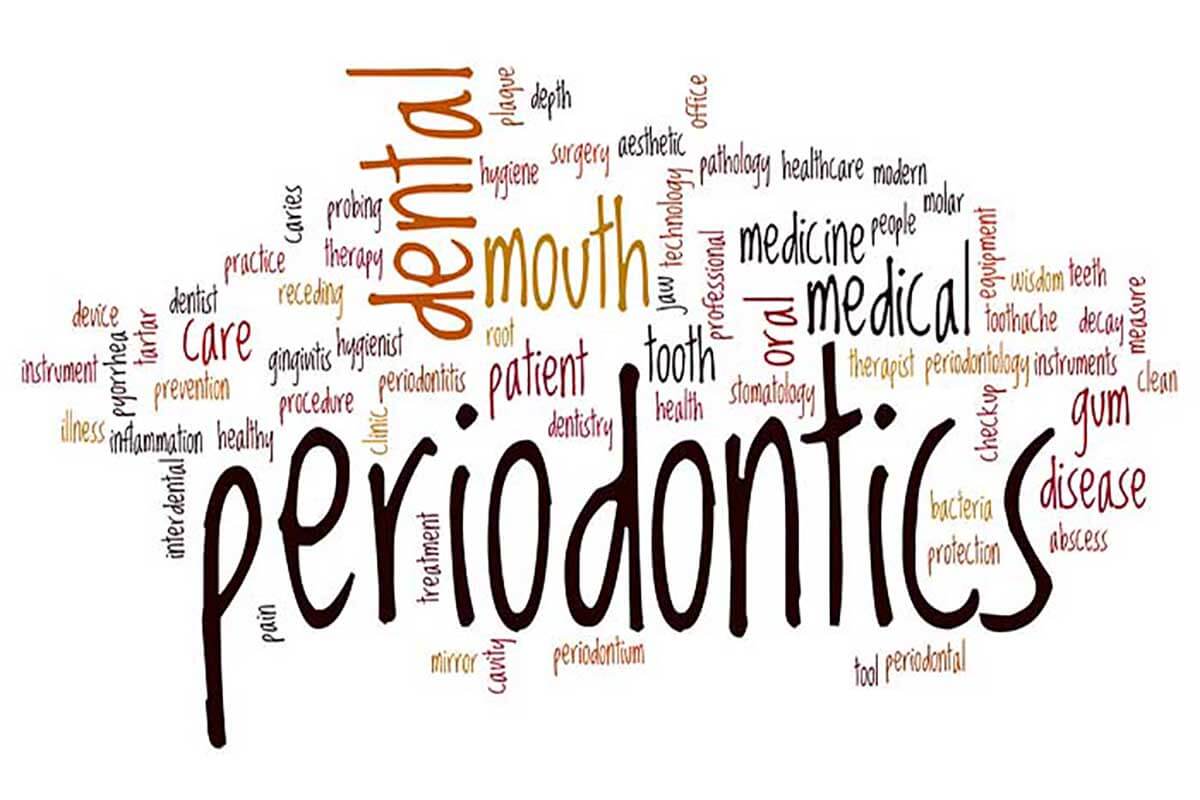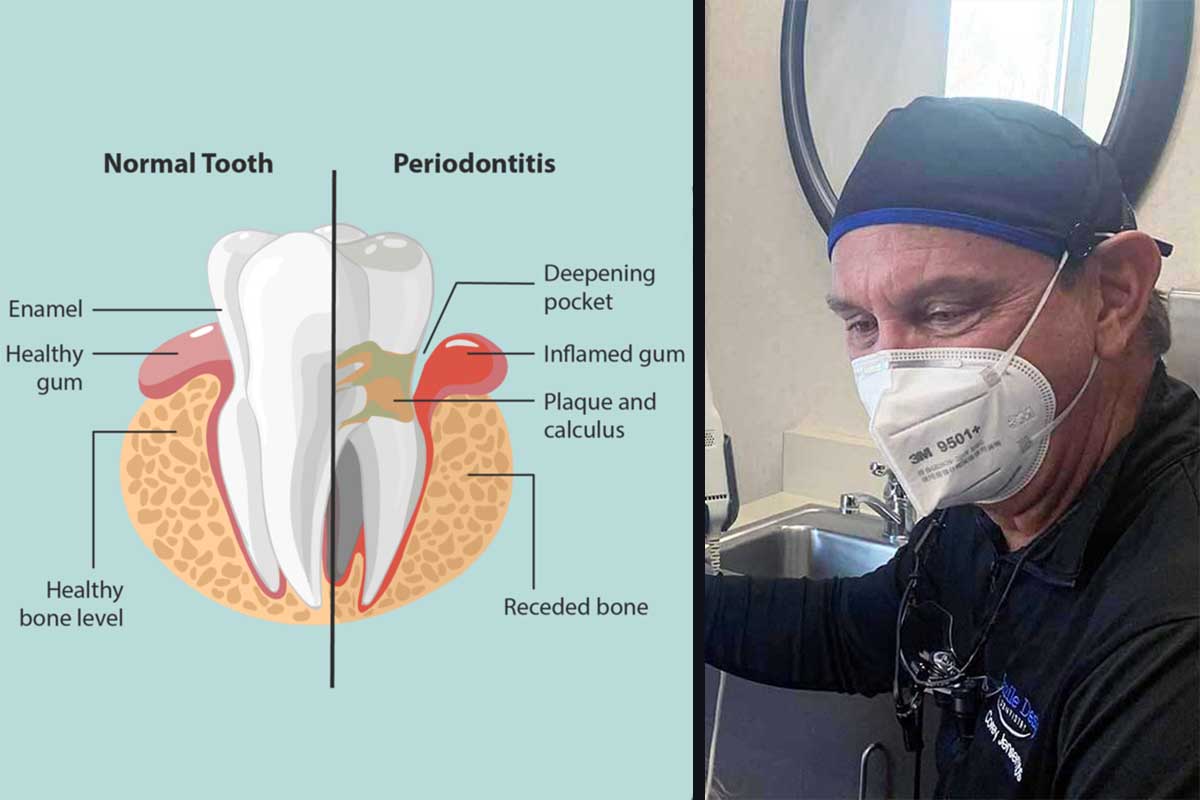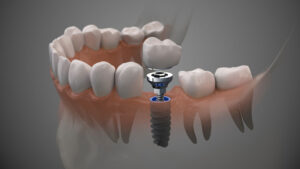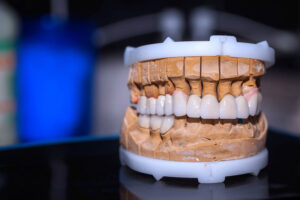What is Periodontal disease? Do I have Periodontitis?
Perhaps you have heard of periodontal disease from your dentist or hygienist and wonder about your oral health.
Perhaps you have heard of a family members dental experience, friends or co-workers talk about it after visiting their dentist. Or, perhaps you have never heard of the term. Whatever the case is it has left you wondering, “Just what is periodontal disease and should I even worry or care about it?”
First let’s start with what periodontal disease is. It is a serious gum infection that damages gums and has the potential to destroy the jawbone. Periodontitis is common but most often easily preventable. As defined by the American Dental Association (ADA): Periodontal (gum) disease is an infection of the tissues that surround and support your teeth. Once we know what periodontal disease is we can then start to answer the other natural questions that follow.
Common Questions About Peridontal Disease:
1) How do I get periodontal disease?
2) What are the symptoms of periodontal disease?
3) What is is occuring in my mouth if I have periodontal disease?
4) How do I treat periodontal disease?
5) What steps do I Take to prevent Periodontal Disease?
6) What are the stages of periodontal disease?
1) How do I get periodontal disease?
Periodontal disease is not something you catch, like a cold. It is not virus-based so you don’t need to worry that someone may be contagious if they share with you that their dentist told them that they have periodontal disease. Periodontal disease is bacteriologically based and forms between your teeth and gums. Everyone has some of this bacteria present in their mouths. It forms in small gaps between gums and teeth that we call “pockets”.
It is when the bacteria becomes so prevalent that it starts to cause damage in various ways to your teeth and body that we now say a person has contracted a periodontal disease.
2) What are the symptoms of periodontal disease?
There are a couple of key indicators that dentists look for to diagnose periodontal disease. The first is called pocket measurement which is measuring how deep the gap is that exists between your teeth and gums. Your hygienist will routinely measure your pocket depths at your dental visit with an instrument they call a “probe”.
A. The probe measures pocket depth in millimeters. When you hear your hygienist mention pocket depths of 1, 2, or 3 this means I millimeter, 2 millimeters or 3 millimeters. These are considered healthy measurements and are a key indicator that periodontal disease is not present. If your hygienist starts mentioning numbers of 4, 5, 6 or higher there is now a concern but a pocket depth alone does not mean you have periodontal disease.
B. The second indicator is if the probing by your hygienist causes your gums to bleed. Bleeding gums along with pocket depths of 4 millimeters or greater will probably lead to a diagnosis of periodontal disease. This periodontal disease is tooth specific. Meaning you can have it on one or all of your teeth. Treatment is, in turn, provided only to the areas where the disease exists.
C.The third indicator is when a CBCT Scan or x-rays reveal tooth loss. An x-ray will show jaw bone that surrounds and holds your teeth in place. A healthy tooth will have plenty of bone from the tooth roots up to the erupted portion of the tooth. A tooth that is compromised with the disease will show that bone holding it has disappeared, to varying degrees, sometimes down all the way to the roots. If they see that bone has disappeared around the tooth it is a clear indication that there is active periodontal disease present.
3) What is occuring in my mouth if I have periodontal disease?
Like I was discussing in the first question everyone has bacteria in the small pockets between their teeth and gums. As long as the pockets stay small, 1mm to 3mm we can take care of the bacteria ourselves with regular brushing, good hygiene habits and regular visits to Smile Design Dentistry for routine cleaning. It is when the pockets reach 4mm or greater that we run into trouble.
We can no longer take care of the bacteria ourselves with home care. In these deeper pockets is where the bacteria can now thrive. They will cause the gums to become swollen, puffy and be made to bleed easily. You may even notice bleeding through your home care. The bacteria are now also able to form attachments to the jaw bone, beneath the gum line. This causes the jawbone to slowly dissolve and disappear, meaning that you may later need a dental implant.
Left alone the tooth may become loose as it loses its bone support and eventually fall out, or need removal due to lack of support. Losing bone (osteoporosis) and teeth due to periodontal disease is not the only concern when the disease is present. Since your beautiful smile matters a lot, take action early.
Periodontal disease has been linked to many other issues to your body including:
Diabetes. Periodontal disease is often considered a complication of diabetes. Those people who don’t have their diabetes under control are especially at risk. The relationship of periodontal disease and diabetes can go both ways. It is suggested that periodontal disease may make it more difficult for people who have diabetes to control their blood sugar. Putting you at risk of diabetic complications.
Heart Disease. Several studies have shown that periodontal disease is associated with heart disease. Researchers believe that inflammation caused by periodontal disease may be responsible for the association. The periodontal disease can also exacerbate existing heart conditions.
Respiratory Disease. It has been found that bacteria growing in the mouth can be aspirated into the lungs to cause respiratory diseases such as pneumonia, especially in people with periodontal disease.
Cancer. There have even been cancer links discovered. Men with periodontal disease were 49% more likely to develop kidney cancer, 54% more likely to develop pancreatic cancer, and 30% more likely to develop blood cancers.
4) How do I treat periodontal disease?
Treatment for periodontal treatment will depend on its severity. The deeper the pockets are the higher level of care you will need. If your pockets are 4mm to 6mm treatment normally be done at Smile Design Dentistry. If pockets are deeper than that, one of our dentists will probably refer you to a specialist called a periodontist.
The treatment by your hygienist at Smile Design Dentistry is called perio scaling and root planing. Our hygienists will use an instrument to get beneath your gum tissue to the bottom of the pocket and destroy the bacteria that is present by scaling roots. This stops the process of bone loss.
Antibiotics may also be placed on the diseased sites to destroy the bacteria.Treatment by a periodontist may include “laying a flap” of gum tissue. This involves cutting the gum tissue to allow treatment to the bottom of the pocket to again, destroy the bacteria.
The truly difficult thing about periodontal disease is that is never fully cured. As I said before the bacteria is always present to some degree in all of us. The goal will be to get the bacteria back to a manageable state where it will stop destroying bone and be able to be kept in check through home care.
Since your pockets will not go back to depths of 3mm or less after the initial perio scaling and root planing treatment your Dr. Jensen, Dr. Moore or your periodontist will probably want to see you every 3 – 4 months. This is so the hygienists can continue to clean beneath your gum line to destroy the bacteria that are trying to reattach to your teeth and bone. It has been found that 3-4 months is the amount of time it takes for bacteria to grow and restart the process of inflaming gums and destroying bone.
After periodontal disease your pockets will probably never get back to 3mm or less but when Dr. Jensen or Dr. Moore feels the disease has gotten to a point of management and not active you will be declared in a state of dental health and go back to see your hygienist every six months for routine care. Be assured, we take extensive procautions to protect your safety during every dental visit.
5) What steps do I Take to prevent Periodontal Disease?
The first step is great home care and regular trips to Smile Design Dentistry for preventive cleaning and exam visits. But, if you have periodontal disease remember, it is an insidious disease. You can’t see it or feel it, and it progresses very slowly. As such, there is a tendency to put off treatment or avoid care.
As detailed above the consequences of putting off care is significant so follow through with recommended treatment. Also, remember that treatment usually is an on-going process with a goal to make the disease manageable. After you follow through with the first step of perio scaling and root planning you will need to return every 3-4 months per Dr. Jensen’s or Dr. Moore’s recommendation. This is vital because if you fail on this step the periodontal disease will return and the initial treatment will have been for naught. Quick follow-through may protect you from developing gingivitis.
6) What are the stages of periodontal disease?
The progression of periodontal disease is often defined by four unique stages: gingivitis, slight periodontal disease, moderate periodontal disease, and advanced periodontal disease.
The good news is that although periodontal disease can create significant health issues it is completely treatable. There is no reason to let it go untreated when it may really impact your oral and overall health. There just has to be the commitment on your end. As dental professionals, we love it when we can help patients obtain a happy and healthy smile.
We see your dental health as a team effort, meaning that the commitment on your end is very important. You’ll love the results if you value Dr. Jensen’s, Dr. Bertrand’s, and Dr. Moore’s guidance by following their recommendations for daily oral health routines as well as any needed treatment.
Schedule an appointment today. Enjoy a healthy mouth and keep your teeth for a lifetime by becoming a team player with Smile Design Dentistry!
 Brian Denn is the Clinic Manager at Smile Design Dentistry in Plymouth, Minnesota. Brian has over 25 years of dental practice management involving making practices run smoother and patient experiences better. He also leads a dental practice managers group staying abreast of the latest dental practice management trends.
Brian Denn is the Clinic Manager at Smile Design Dentistry in Plymouth, Minnesota. Brian has over 25 years of dental practice management involving making practices run smoother and patient experiences better. He also leads a dental practice managers group staying abreast of the latest dental practice management trends.




